Kenmore 66475123610, 66475113610, 66475113611 Installation Guide

Installation Instructions Instrucciones de instalación Instructions d’installation
English/Español/Français
Kenmore®
Gas Range Estufa a gas Cuisinière à gaz
P/N W10884766A
Sears Brands Management Corporation Hoffman Estates, IL 60179 U.S.A.
www.kenmore.com
www.sears.com
Sears Canada Inc.
Toronto, Ontario, Canada M5B 2C3
www.sears.ca
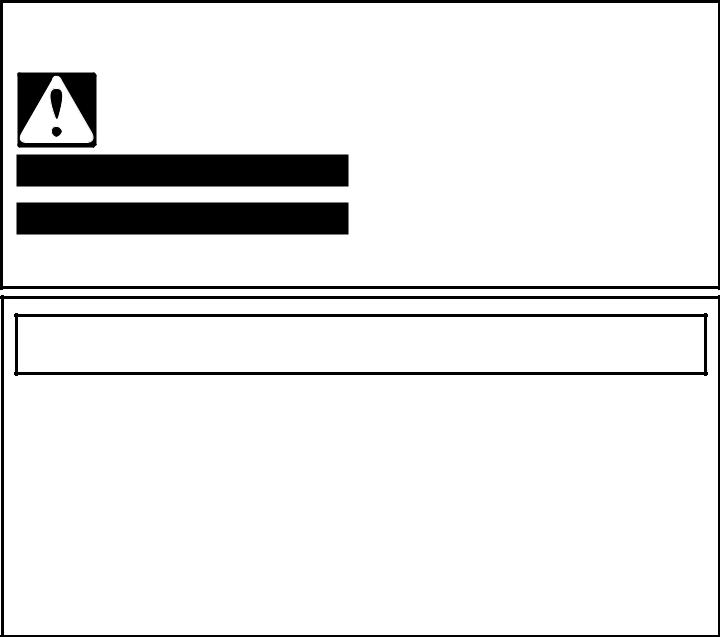
TABLE OF CONTENTS
RANGE SAFETY.................................................................... |
2 |
Make Gas Connection.................................................................. |
10 |
INSTALLATION REQUIREMENTS........................................... |
4 |
Verify Anti-Tip Bracket Is Installed and Engaged..................... |
11 |
Tools and Parts................................................................................. |
4 |
Electronic Ignition System............................................................. |
11 |
Location Requirements.................................................................... |
4 |
Remove/Replace Drawer............................................................. |
12 |
Electrical Requirements................................................................... |
6 |
Oven Door...................................................................................... |
12 |
Gas Supply Requirements.............................................................. |
6 |
Complete Installation.................................................................... |
13 |
INSTALLATION INSTRUCTIONS............................................ |
8 |
GAS CONVERSIONS........................................................... |
14 |
Unpack Range.................................................................................. |
8 |
LP Gas Conversion......................................................................... |
14 |
Install Anti-Tip Bracket.................................................................... |
8 |
Natural Gas Conversion............................................................... |
17 |
Adjust Leveling Legs........................................................................ |
9 |
Adjust Flame Height..................................................................... |
20 |
Level Range.................................................................................... |
10 |
|
|
RANGE SAFETY
Your safety and the safety of others are very important.
many important safety messages in this manual and on your appliance. Always read and obey all safety
safety alert symbol.
alerts you to potential hazards that can kill or hurt you and others.
messages will follow the safety alert symbol and either the word “DANGER” or “WARNING.” mean:
 DANGER
DANGER  WARNING
WARNING
You can be killed or seriously injured if you don't immediately follow instructions.
You can be killed or seriously injured if you don't follow instructions.
All safety messages will tell you what the potential hazard is, tell you how to reduce the chance of injury, and tell you what can happen if the instructions are not followed.
WARNING: If the information in this manual is not followed exactly, a fire or explosion may result causing property damage, personal injury or death.
–Do not store or use gasoline or other flammable vapors and liquids in the vicinity of this or any other appliance.
–WHAT TO DO IF YOU SMELL GAS:
•Do not try to light any appliance.
•Do not touch any electrical switch.
•Do not use any phone in your building.
•Immediately call your gas supplier from a neighbor's phone. Follow the gas supplier's instructions.
•If you cannot reach your gas supplier, call the fire department.
–Installation and service must be performed by a qualified installer, service agency or the gas supplier.
2
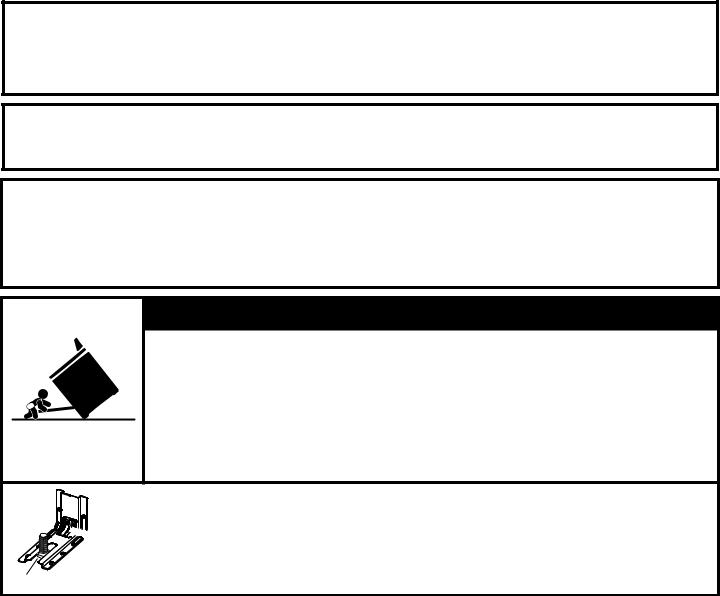
WARNING: Gas leaks cannot always be detected by smell.
Gas suppliers recommend that you use a gas detector approved by UL or CSA.
For more information, contact your gas supplier.
If a gas leak is detected, follow the “What to do if you smell gas” instructions.
IMPORTANT: Do not install a ventilation system that blows air downward toward this gas cooking appliance. This type of ventilation system may cause ignition and combustion problems with this gas cooking appliance resulting in personal injury or unintended operation.
In the State of Massachusetts, the following installation instructions apply:
■Installations and repairs must be performed by a qualified or licensed contractor, plumber, or gasfitter qualified or licensed by the State of Massachusetts.
■If using a ball valve, it shall be a T-handle type.
■A flexible gas connector, when used, must not exceed 3 feet.
 WARNING
WARNING
Tip Over Hazard A child or adult can tip the range and be killed.
Install anti-tip bracket to floor or wall per installation instructions.
Slide range back so rear range foot is engaged in the slot of the anti-tip bracket. Re-engage anti-tip bracket if range is moved.
Do not operate range without anti-tip bracket installed and engaged.
Failure to follow these instructions can result in death or serious burns to children and adults.
Anti-Tip



 Bracket
Bracket
Range Foot
To verify the anti-tip bracket is installed and engaged:
•Slide range forward.
•Look for the anti-tip bracket securely attached to floor or wall.
•Slide range back so rear range foot is under anti-tip bracket.
•See installation instructions for details.
3
INSTALLATION REQUIREMENTS
Tools and Parts
Gather the required tools and parts before starting installation. Read and follow the instructions provided with any tools
listed here.
Tools Needed
■■ Tape measure
■■ Phillips screwdriver
■■ Flat-blade screwdriver
■■ 1/8" (3 mm) flat-blade screwdriver
■■ Level
■■ Drill
■■ Wrench or pliers ■■ Pipe wrench
■■ 15/16" (2.4 cm) combination wrench
■■ 1/8" (3.2 mm) drill bit
(for wood floors)
■■ Marker or pencil
■■ Pipe-joint compound resistant to LP gas
■■ 3/16" (4.8 mm) carbidetipped masonry drill bit (for concrete/ceramic floors)
■■ Noncorrosive leakdetection solution
For LP/Natural Gas Conversions
■■ 5/8" (1.6 cm) combination wrench
■■ 3/8" (1 cm) nut driver ■■ 9/32" (7 mm) nut driver ■■ Masking tape
Parts Supplied
Check that all parts are included. ■■ LP/Natural Gas Conversion Kit
■■ #10 x 15/8" (4.1 cm) screws
(for mounting anti-tip bracket) (2)
■■ Anti-tip bracket (inside oven cavity)
Anti-tip bracket must be securely mounted to the back wall or floor. Thickness of flooring may require longer screws
to anchor bracket to subfloor. Longer screws are available from your local hardware store.
Parts Needed
Check local codes and consult gas supplier. Check existing gas supply and electrical supply. See the “Electrical Requirements” and “Gas Supply Requirements” sections.
Location Requirements
IMPORTANT: Observe all governing codes and ordinances.
Do not obstruct flow of combustion and ventilation air.
■■ It is the installer’s responsibility to comply with installation clearances specified on the model/serial/rating plate. The model/serial/rating plate is located behind the oven door on the top left-hand side of the oven frame.
■■ The range should be located for convenient use in the kitchen.
■■ Recessed installations must provide complete enclosure of the sides and rear of the range.
■■ To eliminate the risk of burns or fire by reaching over the heated surface units, cabinet storage space located above the surface units should be avoided. If cabinet storage
is to be provided, the risk can be reduced by installing a range hood or microwave hood combination that projects horizontally a minimum of 5" (12.7 cm) beyond the bottom of the cabinets.
■■ All openings in the wall or floor where range is to be installed must be sealed.
■■ Cabinet opening dimensions that are shown must be used. Given dimensions are minimum clearances.
■■ The anti-tip bracket must be installed. To install the anti-tip bracket shipped with the range, see the “Install Anti-Tip Bracket” section.
■■ Grounded electrical supply is required. See the “Electrical Requirements” section.
■■ Proper gas supply connection must be available. See the “Gas Supply Requirements” section.
■■ Contact a qualified floor covering installer to check that the floor covering can withstand at least 200°F (93°C).
■■ Use an insulated pad or 1/4" (0.64 cm) plywood under range if installing range over carpeting.
IMPORTANT: To avoid damage to your cabinets, check with your builder or cabinet supplier to make sure that the materials used will not discolor, delaminate, or sustain other
damage. This oven has been designed in accordance with the requirements of UL and CSA International and complies with the maximum allowable wood cabinet temperatures of 194°F (90°C).
4
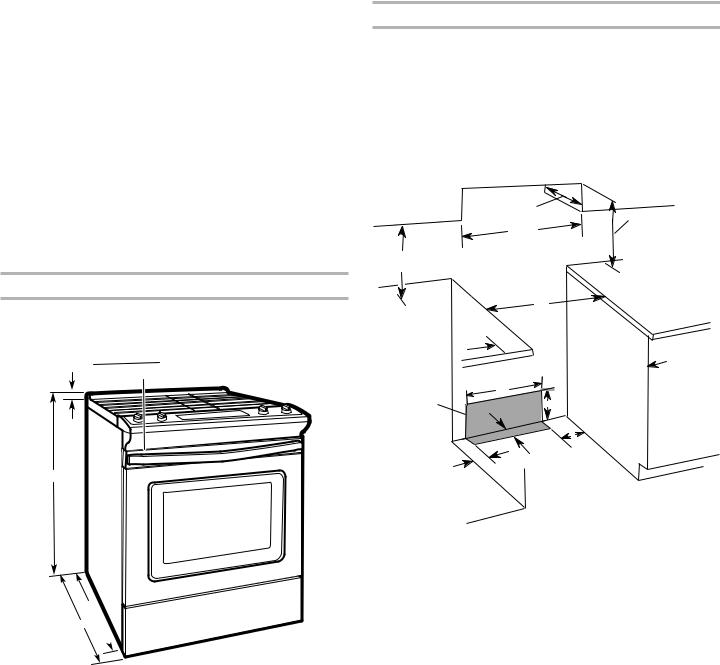
Mobile Home - Additional Installation Requirements
The installation of this range must conform to the Manufactured Home Construction and Safety Standard,
Title 24 CFR, Part 3280 (formerly the Federal Standard for
Mobile Home Construction and Safety, Title 24, HUD Part 280). When such standard is not applicable, use the Standard for Manufactured Home Installations, ANSI A225.1/NFPA 501A or local codes.
In Canada, the installation of this range must conform with the current standards CAN/CSA - A240-latest edition or with local codes.
Mobile Home Installations Require:
■■ When this range is installed in a mobile home, it must be secured to the floor during transit. Any method of securing the range is adequate as long as it conforms to the standards listed above.
Product Dimensions
This manual covers several models. Your model may appear different from the models depicted. Dimensions given are maximum dimensions across all models.
A  C B
C B

D
E
F 
A.13/16" (3.0 cm) height from cooktop to top of vent
B.297/8" (75.9 cm)
C.Model/serial/rating plate (located behind the oven door on the top left-hand side of the oven frame)
D.36" (91.4 cm) height to top of cooktop edge with leveling legs screwed in all the way*
E.2825/64" (72.1 cm) max. depth from front of console to back of range
F.291/64" (73.7 cm) max. depth from handle to back of range
IMPORTANT: Range must be level after installation. Follow the instructions in the “Level Range” section. Using the cooktop as a reference for leveling the range is not recommended.
*Range can be raised approximately 1" (2.5 cm) by adjusting the leveling legs.
Cabinet Dimensions
Cabinet opening dimensions shown are for 25" (64.0 cm) countertop depth, 24" (61.0 cm) base cabinet depth, and
36" (91.4 cm) countertop height.
IMPORTANT: If installing a range hood or microwave hood combination above the range, follow the range hood or microwave hood combination installation instructions for dimensional clearances above the cooktop surface.
Range may be installed next to combustible walls with zero clearance.
B |
D |
|
C |
||
|
A
|
|
E |
|
|
F |
|
|
M |
G |
|
H |
|
I |
|
|
|
L |
|
J |
K |
|
|
A.18" (45.7 cm) upper side cabinet to countertop
B.13" (33 cm) max. upper cabinet depth
C.30" (76.2 cm) min. opening width
D.For minimum clearance to top of cooktop, see NOTE.
E.30" (76.2 cm) min. opening width
F.3" (7.6 cm) min. clearance from both sides of range to side wall or other combustible material
G.The shaded area is recommended for installation of rigid gas pipe and grounded outlet.
H.131/8" (33.3 cm)
I.711/16" (19.5 cm)
J.413/16" (12.2 cm)
K.311/16" (9.4 cm)
L.12" (30.5 cm)
M.Cabinet door or hinges should not extend into the cutout.
NOTE: 24" (61.0 cm) minimum when bottom of wood or metal cabinet is shielded by not less than 1/4" (0.64 cm) flame retardant millboard covered with not less than No. 28
MSG sheet steel, 0.015" (0.4 mm) stainless steel, 0.024"
(0.6 mm) aluminum or 0.020" (0.5 mm) copper.
30" (76.2 cm) minimum clearance between the top of the cooking platform and the bottom of an uncovered wood or metal cabinet.
5
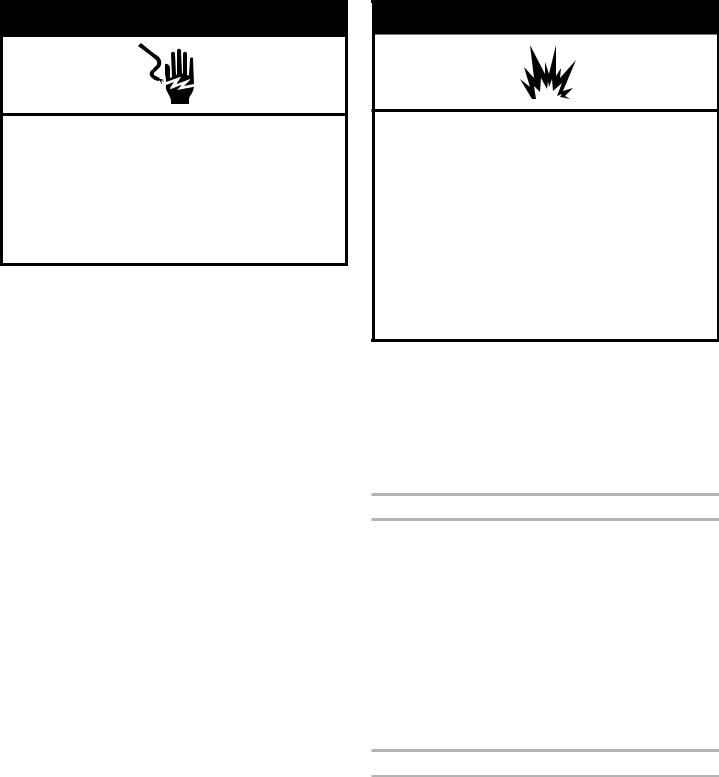
Electrical Requirements
 WARNING
WARNING
Electrical Shock Hazard Plug into a grounded 3 prong outlet. Do not remove ground prong.
Do not use an adapter.
Do not use an extension cord.
Failure to follow these instructions can result in death, fire, or electrical shock.
IMPORTANT: The range must be electrically grounded in accordance with local codes and ordinances, or in the absence of local codes, with the National Electrical Code, ANSI/NFPA 70 or Canadian Electrical Code, CSA C22.1.
This range is equipped with an electronic ignition system that will not operate properly if plugged into an outlet that is not properly polarized.
If codes permit and a separate ground wire is used, it is recommended that a qualified electrical installer determine that the ground path is adequate.
A copy of the above code standards can be obtained from:
National Fire Protection Association
1 Batterymarch Park
Quincy, MA 02169-7471
CSA International
8501 East Pleasant Valley Road
Cleveland, OH 44131-5575
■■ A 120-volt, 60 Hz., AC-only, 15-amp fused, grounded, and polarized electrical circuit is required. A time-delay fuse or circuit breaker is also recommended. It is recommended that a separate circuit serving only this range be provided.
■■ Electronic ignition systems operate within wide voltage limits, but proper grounding and polarity are necessary. Check that the outlet provides 120-volt power and is correctly grounded.
■■ This gas range is not required to be plugged into a GFCI (Ground-Fault Circuit Interrupter) outlet. It is recommended that you not plug an electric spark ignition gas range or any other major appliance into a GFCI wall outlet as it may cause the GFCI to trip during normal cycling.
■■ Performance of this range will not be affected if operated on a GFCI-protected circuit. However, occasional nuisance tripping of the GFCI breaker is possible due to the normal operating nature of electronic gas ranges.
■■ The tech sheet and wiring diagram are located on the back of the range in a plastic bag.
NOTE: The metal chassis of the range must be grounded in order for the control panel to work. If the metal chassis of the range is not grounded, no keypads will operate.
Check with a qualified electrician if you are in doubt as
6 to whether the metal chassis of the range is grounded.
Gas Supply Requirements
 WARNING
WARNING
Explosion Hazard
Use a new CSA International approved gas supply line. Install a shut-off valve.
Securely tighten all gas connections.
If connected to LP, have a qualified person make sure gas pressure does not exceed 14" (36 cm) water column.
Examples of a qualified person include:
licensed heating personnel,
authorized gas company personnel, and authorized service personnel.
Failure to do so can result in death, explosion, or fire.
Observe all governing codes and ordinances.
IMPORTANT: This installation must conform with all local codes and ordinances. In the absence of local codes, installation must conform with American National Standard, National Fuel Gas Code ANSI Z223.1 - latest edition or CAN/CGA B149 - latest edition.
IMPORTANT: Leak testing of the range must be conducted according to the manufacturer’s instructions.
Type of Gas
Natural Gas:
This range is factory set for use with Natural gas. See the “Gas Conversions” section. The model/serial/rating plate located on the oven frame behind the top left-hand side of the oven door has information on the types of gas that can be used. If the types of gas listed do not include the type of gas available, check with the local gas supplier.
LP Gas Conversion:
Conversion must be done by a qualified service technician.
No attempt shall be made to convert the appliance from the gas specified on the model/serial/rating plate for use with a different gas without consulting the serving gas supplier. See the “Gas Conversions” section.
Gas Supply Line
■■ Provide a gas supply line of 3/4" (1.9 cm) rigid pipe to the range location. A smaller size pipe on longer runs may result in insufficient gas supply. With LP gas, piping or tubing size can be 1/2" (1.3 cm) minimum. Usually, LP gas suppliers determine the size and materials used in the system.
NOTE: Pipe-joint compounds that resist the action of LP gas must be used. Do not use TEFLON®† tape.
†®TEFLON is a registered trademark of Chemours.
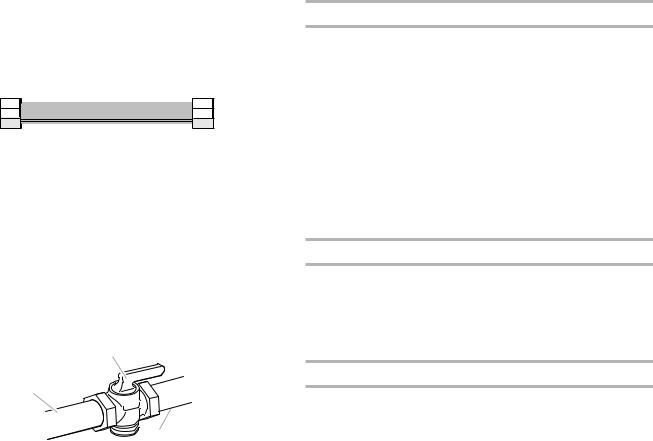
Flexible Metal Appliance Connector:
■■ If local codes permit, a new CSA design-certified, 4 to 5 ft (122 to 152.4 cm) long, 1/2" or 3/4"
(1.3 or 1.9 cm) I.D. (inside diameter), flexible metal appliance connector may be used for connecting range to the gas supply line.
■■ A 1/2" (1.3 cm) male pipe thread is needed for connection to the female pipe threads of the inlet to the appliance pressure regulator.
■■ Do not kink or damage the flexible metal tubing when moving the range.
■■ Must include a shut-off valve:
The supply line must be equipped with a manual shut-off valve. This valve should be located in the same room but external to the range opening, such as an adjacent cabinet. It should be in a location that allows ease of opening and closing. Do not block access to shut-off valve. The valve is for turning on or shutting off gas to the range.
B
A
C
A.Gas supply line
B.Shut-off valve open position
C.To range
Gas Pressure Regulator
The gas pressure regulator supplied with this range must be used. The inlet pressure to the regulator should be as follows for proper operation:
Natural Gas:
Minimum pressure: 6" WCP Maximum pressure: 14" WCP
LP Gas:
Minimum pressure: 11" WCP Maximum pressure: 14" WCP
Contact local gas supplier if you are not sure about the inlet pressure.
Burner Input Requirements
Input ratings shown on the model/serial/rating plate are for elevations up to 2,000 ft (609.6 m).
For elevations above 2,000 ft (609.6 m), ratings are reduced at a rate of 4% for each 1,000 ft (304.8 m) above sea level (not applicable for Canada).
Gas Supply Pressure Testing
Gas supply pressure for testing regulator must be at least 1" water column pressure above the manifold pressure shown on the model/serial/rating plate.
Line Pressure Testing Above 1/2 psi Gauge (14" WCP)
The range and its individual shut-off valve must be disconnected from the gas supply piping system during any pressure testing of that system at test pressures in excess of
1/2 psi (3.5 kPa).
Line Pressure Testing at 1/2 psi Gauge (14" WCP) or Lower
The range must be isolated from the gas supply piping system by closing its individual manual shut-off valve during any pressure testing of the gas supply piping system at test pressures equal to or less than 1/2 psi (3.5 kPa).
7
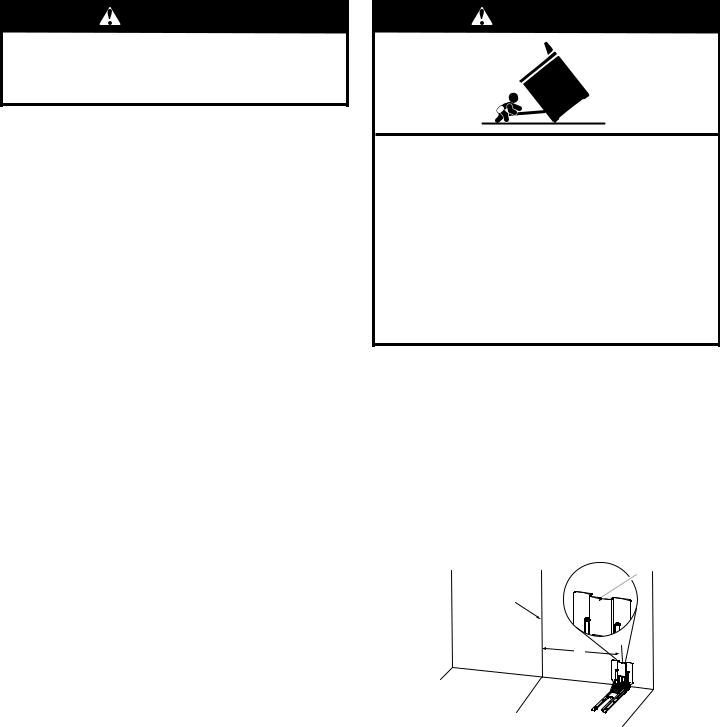
INSTALLATION INSTRUCTIONS
Unpack Range
ARNING
Excessive Weight Hazard
Use two or more people to move and install range. Failure to do so can result in back or other injury.
1.Remove shipping materials, tape, and film from the range.
Keep cardboard bottom under range. Do not dispose of anything until the installation is complete.
2.Remove oven racks and parts package from oven and shipping materials.
3.To remove cardboard bottom, first take 4 cardboard corners from the carton. Stack one cardboard corner on top of another. Repeat with the other 2 corners. Place them lengthwise on the floor behind the range to support the range when it is laid on its back.
4.Using 2 or more people, firmly grasp the range and gently lay it on its back on the cardboard corners.
5.Remove cardboard bottom.
The leveling legs can be adjusted while the range is on its back. See the “Adjust Leveling Legs” section.
NOTE: To place range back up into a standing position, put a sheet of cardboard or hardboard on the floor in front of range to protect the flooring. Using 2 or more people, stand range back up onto the cardboard or hardboard.
Install Anti-Tip Bracket
ARNING
Tip Over Hazard
A child or adult can tip the range and be killed.
Install anti-tip bracket to floor or wall per installation instructions.
Slide range back so rear range foot is engaged in the slot of the anti-tip bracket.
Re-engage anti-tip bracket if range is moved.
Do not operate range without anti-tip bracket installed and engaged.
Failure to follow these instructions can result in death or serious burns to children and adults.
1.Remove the anti-tip bracket from the inside of the oven.
2.Determine which mounting method to use: floor or wall.
If you have a stone or masonry floor, you can use the wall mounting method. If you are installing the range in a mobile home, you must secure the range to the floor.
This anti-tip bracket and screws can be used with wood or metal studs.
3.Determine and mark centerline of the cutout space. The mounting bracket can be installed on either the left-hand or right-hand side of the cutout. Position mounting bracket against the wall in the cutout so that the V-notch of the bracket is 121/2" (31.8 cm) from centerline, as shown.
B
Centerline
A
A.121/2" (31.8 cm)
B.Bracket V-notch
8

4.Drill two 1/8" (3 mm) holes that correspond to the bracket holes of the determined mounting method. See the following illustrations.
Floor Mounting
Rear position |
Front position |
Diagonal (2 options) |
Wall Mounting
5.Using the two #10 x 15/8" (4.1 cm) Phillips-head screws provided, mount anti-tip bracket to the wall or floor.
6.Move range close enough to opening to allow for final electrical connections. Remove shipping base, cardboard, or hardboard from under range.
7.Move range into its final location, making sure rear leveling leg slides into anti-tip bracket.
8.Move range forward onto shipping base, cardboard, or hardboard to continue installing the range, using the following installation instructions.
Adjust Leveling Legs
1.If range height adjustment is necessary, use a wrench or pliers to loosen the 4 leveling legs.
This may be done with the range on its back or with the range supported on 2 legs after the range has been placed back to a standing position.
NOTE: To place range back up into a standing position, put a sheet of cardboard or hardboard in front of range. Using 2 or more people, stand range back up onto the cardboard or hardboard.
ARNING
Tip Over Hazard
A child or adult can tip the range and be killed.
Install anti-tip bracket to floor or wall per installation instructions.
Slide range back so rear range foot is engaged in the slot of the anti-tip bracket.
Re-engage anti-tip bracket if range is moved.
Do not operate range without anti-tip bracket installed and engaged.
Failure to follow these instructions can result in death or serious burns to children and adults.
2.Measure the distance from the top of the counter to the floor.
3.Measure the distance from the top of the cooktop to the bottom of the leveling legs. This distance should be the same. If it is not, adjust the leveling legs to the correct height. The leveling legs can be loosened to add up to a maximum of 1" (2.5 cm). A minimum of 3/16" (5 mm) is needed to engage the anti-tip bracket.
NOTE: If height adjustment is made when range is standing, tilt the range back to adjust the front legs, and then tilt forward to adjust the rear legs.
4.When the range is at the correct height, check that there is adequate clearance under the range for the anti-tip bracket. Before sliding range into its final location, check that the antitip bracket will slide under the range and onto the rear leveling leg prior to anti-tip bracket installation.
NOTE: If a Trim Kit will be used, the top of the cooktop should be higher than the counter. See the Installation Instructions included with the Trim Kit for the correct height.
9

Level Range
1.Place level on the oven bottom, as indicated in one of the
2 figures below, depending on the size of the level. Check with the level side to side and front to back.
2.If range is not level, use a wrench or pliers to adjust leveling legs up or down until the range is level.
Make Gas Connection
 WARNING
WARNING
Explosion Hazard
Use a new CSA International approved gas supply line. Install a shut-off valve.
Securely tighten all gas connections.
If connected to LP, have a qualified person make sure gas pressure does not exceed 14" (36 cm) water column.
Examples of a qualified person include:
licensed heating personnel,
authorized gas company personnel, and authorized service personnel.
Failure to do so can result in death, explosion, or fire.
This range is factory set for use with Natural gas. To use this range with LP gas, see the “Gas Conversions” section before connecting this range to the gas supply. Gas conversions from Natural gas to LP gas or from LP gas to Natural gas must be done by a qualified installer.
Typical Flexible Connection
1.Apply pipe-joint compound made for use with LP gas to the smaller thread ends of the flexible connector adapters. See
B and G in the following illustration.
2.Attach 1 adapter to the gas pressure regulator and the other adapter to the gas shut-off valve. Tighten both adapters, being certain not to move or turn the gas pressure regulator.
3.Use a 15/16" (2.4 cm) combination wrench and an adjustable wrench to attach the flexible connector to the adapters.
IMPORTANT: All connections must be wrench-tightened. Do not make connections to the gas regulator too tight. Making the connections too tight may crack the regulator and cause a gas leak. Do not allow the regulator to turn when tightening fittings.
A
B C
D
E
|
|
H G |
F |
A. Gas pressure regulator |
E. |
Manual gas shut-off valve |
|
B. Use pipe-joint compound. |
F. |
1/2" (1.3 cm) or 3/4" (1.9 cm) |
|
C. Adapter (must have 1/2" |
|
gas pipe |
|
[1.3 cm] male pipe thread) |
G. Use pipe-joint compound. |
||
D. Flexible connector |
H. Adapter |
|
|
Complete Connection
1.Check that the gas pressure regulator shut-off valve is in the On position.
 A
A
A.Gas pressure regulator shut-off valve shown in the On position
2.Open the manual shut-off valve in the gas supply line. The valve is open when the handle is parallel to the gas pipe.
A
B
A.Closed valve
B.Open valve
3.Test all connections by brushing on an approved noncorrosive leak-detection solution. If bubbles appear, a leak is indicated. Correct any leak found.
4.Remove cooktop burner caps and bases from package containing parts.
5.Align the gas tube opening in the burner base with the orifice holder on the cooktop and the igniter electrode with the notch in the burner base.
10
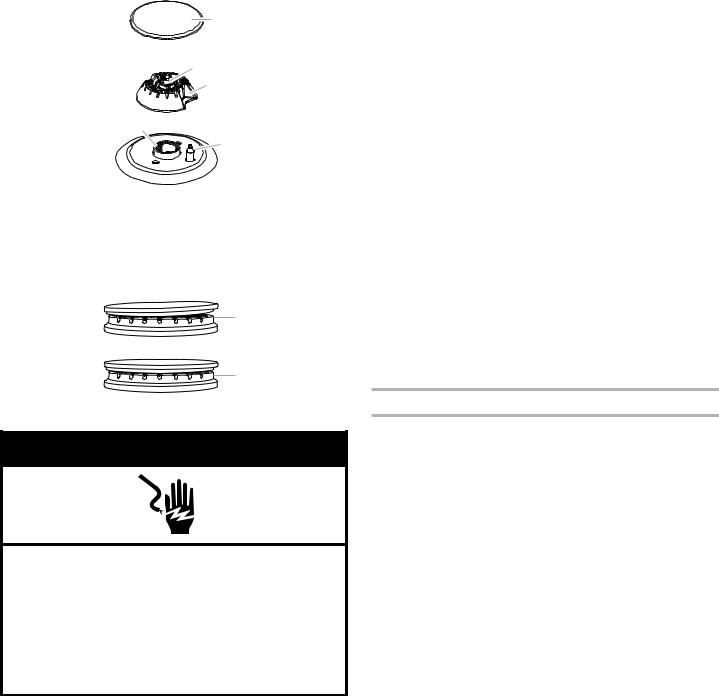
|
|
A |
|
|
B |
|
|
C |
|
E |
|
|
|
D |
A. Burner cap |
D. Igniter electrode |
|
B. |
Gas tube opening |
E. Orifice holder |
C. |
Burner base |
|
Burner caps should be level when properly positioned. If burner caps are not properly positioned, surface burners will not light. The burner cap should not rock or wobble when properly aligned.
A
B
A.Incorrect
B.Correct
 WARNING
WARNING
Electrical Shock Hazard Plug into a grounded 3 prong outlet. Do not remove ground prong.
Do not use an adapter.
Do not use an extension cord.
Failure to follow these instructions can result in death, fire, or electrical shock.
6. Plug into a grounded 3 prong outlet.
Verify Anti-Tip Bracket
Is Installed and Engaged
1.Slide range into final location, making sure rear leveling leg slides into anti-tip bracket.
2.Remove the storage drawer. See the “Remove/Replace Drawer” section.
3.Use a flashlight to look underneath the bottom of the range.
4.Visually check that the rear range foot is inserted into the slot of the anti-tip bracket.
Electronic Ignition System
Initial Lighting and Gas Flame Adjustments
Cooktop and oven burners use electronic igniters in place of standing pilots. When the cooktop control knob is turned to the Lite position, the system creates a spark to light the burner. All cooktop burners will spark, but only the burner with the control knob turned to the Lite position will produce a flame.
This sparking continues as long as the control knob is turned to the Lite position.
When the oven control is turned to the desired setting, sparking occurs and ignites the gas.
Check Operation of Cooktop Burners
Standard Surface Burners
Push in and turn each control knob to the Lite position.
The flame should light within 4 seconds. The first time a burner is lit, it may take longer than 4 seconds to light because of air in the gas line.
If Burners Do Not Light Properly:
■■ Turn cooktop control knob to the Off position.
■■ Check that the range is plugged into a grounded 3 prong outlet. Check that the circuit breaker has not tripped or the household fuse has not blown.
■■ Check that the gas shut-off valves are set to the open position.
■■ Check that burner caps are properly positioned on burner bases.
Repeat startup. If a burner does not light at this point, turn the control knobs to the Off position and contact your dealer or authorized service company for assistance. Please reference the back cover of the Use & Care Guide to contact service.
If the cooktop low burner flame needs to be adjusted for any of the burners, see the “Adjust Flame Height” section.
11
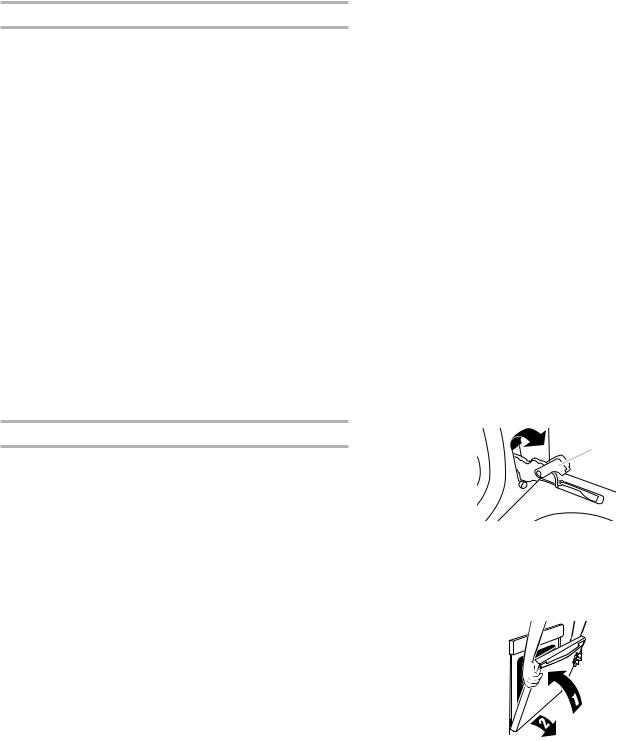
Check Operation of Oven Bake Burner
1.Press BAKE.
2.Press the Start keypad.
The oven burner should light within 8 seconds. The first time a burner is lit, it may take longer than 8 seconds to light because of air in the gas line.
3.After 2 minutes, open the oven door and check that the oven is warm.
If Burner Does Not Light Properly:
■■ Press the Cancel keypad.
■■ Check that the range is plugged into a grounded 3 prong outlet. Check that the circuit breaker has not tripped or the household fuse has not blown.
■■ Check that the gas shut-off valves are set to the open position.
Repeat steps 1 through 3. If the burner does not light at this point, press the Cancel keypad and contact your dealer or authorized service company for assistance. Please reference the back cover of the Use & Care Guide to contact service.
If the bake burner flame needs to be adjusted, see the “Adjust
Flame Height” section.
Refer to the Use & Care Guide for proper operation of the oven controls.
Check Operation of Oven Broil Burner
1.Close the oven door.
2.Press BROIL.
3.Press the Start keypad.
The oven burner should light within 8 seconds. The first time a burner is lit, it may take longer than 8 seconds to light because of air in the gas line.
4.After 2 minutes, open the oven door and check that the oven is warm.
If Burner Does Not Light Properly:
■■ Press the Cancel keypad.
■■ Check that the range is plugged into a grounded 3 prong outlet. Check that the circuit breaker has not tripped or the household fuse has not blown.
■■ Check that the gas shut-off valves are set to the open position.
Repeat steps 1 to 3. If the burner does not light at this point, press the Cancel keypad and contact your dealer or authorized service company for assistance. Please reference the back cover of the Use & Care Guide to contact service.
If the broil burner flame needs to be adjusted, see the “Adjust
Flame Height” section.
Refer to the Use & Care Guide for proper operation of the oven controls.
Remove/Replace Drawer
Remove all items from inside the storage drawer, and then allow the range to cool completely before attempting to remove the drawer.
To Remove:
1.Open the drawer to its fully open position.
2.Raise the front edge and then lift out.
To Replace:
1.Align the forward drawer notches with the notches in the drawer rails on both sides. Place the rear alignment tabs into the drawer rails on both sides.
2.Push the drawer in all the way.
3.Gently open and close the drawer to ensure it is seated properly on the rails on both sides.
Oven Door
For normal range use, it is not suggested to remove the oven door. However, if removal is necessary, make sure the oven is OFF and cool. Then, follow these instructions. The oven door is heavy.
To Remove:
1.Open oven door all the way.
2.Pinch the hinge latch between 2 fingers and pull forward.
Repeat on other side of oven door.
A
A.Hinge latch
3.Close the oven door as far as it will shut.
4.Lift the oven door while holding both sides.
Continue to push the oven door closed and pull it away from the oven doorframe.
12
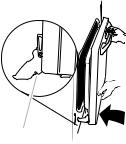
To Replace:
1.Insert both hanger arms into the door. Be sure that the hinge notches are engaged in the oven doorframe.
A
A. Hinge notch
2.Open the oven door.
The door should be able to open all the way.
3.Move the hinge levers back to the locked position.
Check that the door is free to open and close and is level while closed. If it is not, repeat the removal and installation procedures.
Complete Installation
1.Check that all parts are now installed. If there is an extra part, go back through the steps to see which step was skipped.
2.Check that you have all of your tools.
3.Check that you have all of the range accessories, especially oven racks. These accessories may be in the range packaging.
4.Dispose of/recycle all packaging materials.
5.Check that the range is level. See the “Level Range” section.
6.Use a mild solution of liquid household cleaner and warm water to remove waxy residue caused by shipping material. Dry thoroughly with a soft cloth. For more information, see the “Range Care” section of the Use & Care Guide.
7.Read the Use & Care Guide.
8.Turn on surface burners and oven. See the Use & Care
Guide for specific instructions on range operation.
NOTE: Odors and smoke are normal when the oven is used the first few times.
If Range Does Not Operate, Check the Following:
■■ Household fuse is intact and tight or circuit breaker has not tripped.
■■ Gas pressure regulator shut-off valve is in the open position.
■■ Range is plugged into a grounded 3 prong outlet. ■■ Electrical supply is connected.
9.When the range has been ON for 5 minutes, check for heat. If the range is cold, turn off the range and check that the gas supply line shut-off valve is open.
■■ If the gas supply line shut-off valve is closed, open it and then repeat the 5-minute test as outlined above.
■■ If the gas supply line shut-off valve is open, close it, and contact a qualified technician.
If You Need Assistance or Service:
Please reference the back cover of the Use & Care Guide to contact service.
13
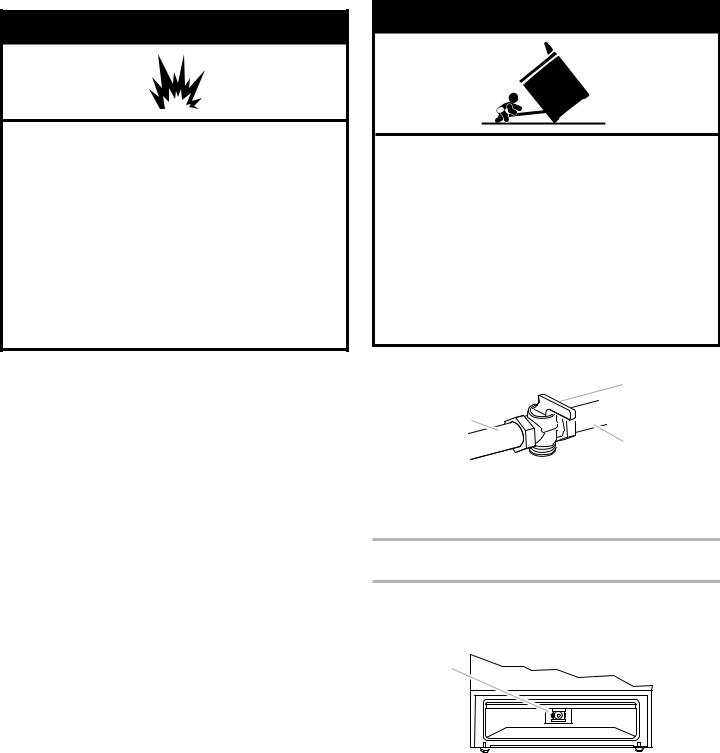
GAS CONVERSIONS
Gas conversions from Natural gas to LP gas or from LP gas to Natural gas must be done by a qualified installer.
 WARNING
WARNING
Explosion Hazard
Use a new CSA International approved gas supply line. Install a shut-off valve.
Securely tighten all gas connections.
If connected to LP, have a qualified person make sure gas pressure does not exceed 14" (36 cm) water column.
Examples of a qualified person include:
licensed heating personnel,
authorized gas company personnel, and authorized service personnel.
Failure to do so can result in death, explosion, or fire.
LP Gas Conversion
 WARNING
WARNING
Tip Over Hazard
A child or adult can tip the range and be killed.
Install anti-tip bracket to floor or wall per installation instructions.
Slide range back so rear range foot is engaged in the slot of the anti-tip bracket.
Re-engage anti-tip bracket if range is moved.
Do not operate range without anti-tip bracket installed and engaged.
Failure to follow these instructions can result in death or serious burns to children and adults.
1. Turn the manual shut-off valve to the closed position.
B
A
C
A.Gas supply line
B.Manual shut-off valve closed position
C.To range
2.Unplug range or disconnect power.
To Convert Gas Pressure Regulator (Natural Gas
to LP Gas)
1.Remove the storage drawer. See the “Remove/Replace Drawer” section.
2.Locate gas pressure regulator at rear of the drawer compartment.
A
A. Gas pressure regulator
IMPORTANT: Do not remove the gas pressure regulator.
14
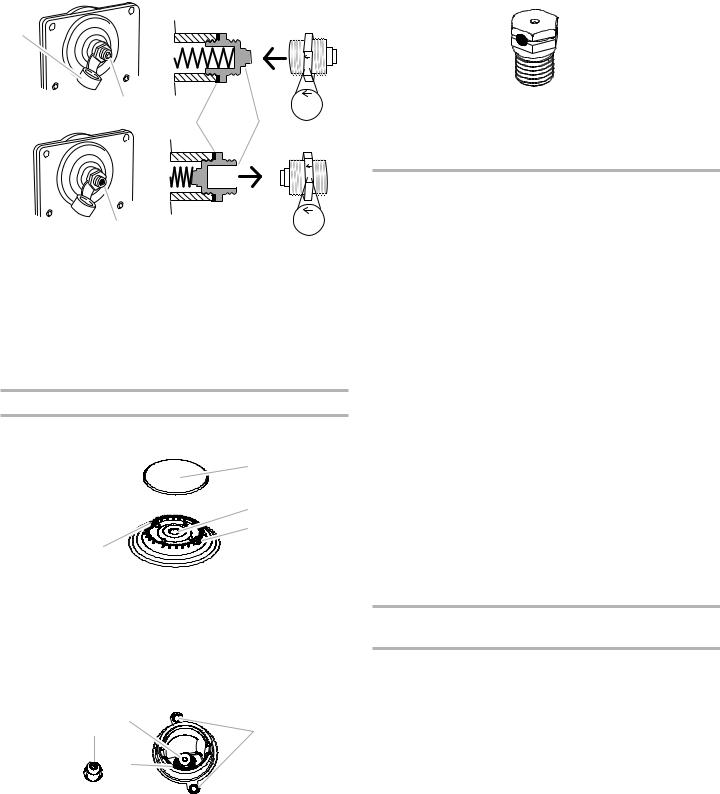
3.Remove plastic cover from gas pressure regulator cap.
4.Turn gas pressure regulator cap counterclockwise with a 5/8" (1.6 cm) combination wrench to remove. NOTE: Do not remove the spring beneath the cap.
|
Side view before |
|
|
A |
|
|
|
|
|
|
NG |
B |
|
|
NG |
|
D |
E |
|
|
|
||
|
|
|
LP |
C |
Side view after |
|
LP |
|
|
|
A.Plastic cover
B.Gas pressure regulator cap with solid end facing out
C.Gas pressure regulator cap with hollow end facing out
D.Washer
E.Gas pressure regulator cap
5.Turn over the gas pressure regulator cap and reinstall on regulator so that the hollow end faces out and the marking “ê LP” is facing the direction shown in the above drawing.
6.Replace plastic cover over gas pressure regulator cap.
To Convert Surface Burners (Natural Gas to LP Gas)
1.Remove burner cap.
2.Remove the burner base.
B
C
D
A
A.Igniter electrode
B.Burner cap
C.Gas tube opening
D.Burner base
3.Apply masking tape to the end of a 9/32" (7 mm) nut driver to help hold the gas orifice spud in the nut driver while changing it. Press nut driver down onto the gas orifice spud and remove by turning it counterclockwise and lifting out.
Set gas orifice spud aside.
A |
B |
D |
|
||
|
C |
|
A.Igniter electrode
B.Orifice spud
C.Orifice spud holder
D.Screws
4.Remove the orifice spuds shipped in the literature package in the oven. Gas orifice spuds are stamped with a number, marked with 1 or 2 color dots, and have a groove in the hex area. Replace the Natural gas orifice spud with the correct LP gas orifice spud.
 A
A
A. LP groove
Refer to the following chart for correct LP gas orifice spud ratings and to spud holder card for proper placement.
LP Gas Orifice Spud Chart for Surface Burners
Burner |
Color |
Size |
ID |
Placement |
Rating/Type |
|
(mm) |
number |
|
15,000 BTU/ |
Silver |
1.05 |
L105 |
LF |
Stacked* |
Black/Orange |
0.32 |
L32 |
|
|
|
|
|
|
14.200 |
Silver |
1.05 |
L105 |
LF/RF |
BTU/Ultra/ |
|
|
|
|
Stacked* |
|
|
|
|
|
|
|
|
|
8.000 BTU/ |
Red/Orange |
0.85 |
L85 |
RR/CTR |
Semi |
|
|
|
|
|
|
|
|
|
5,000 BTU/ |
Red/Blue |
0.65 |
L65 |
LR |
Auxi |
|
|
|
|
|
|
|
|
|
1,200 BTU/ |
Black/Orange |
0.32 |
L32 |
LF |
Stacked/ |
|
|
|
(Simmer) |
Simmer* |
|
|
|
|
*Not in all kits/models
NOTE: Refer to the model/serial/rating plate located on the oven frame behind the top left-hand side of the oven door for proper sizing of spuds for each burner location.
5.Place Natural gas orifice spuds in the orifice spud bag.
IMPORTANT: Keep the Natural gas orifice spuds in case of reinstallation with Natural gas.
6.Replace the burner base.
7.Replace burner cap.
8.Repeat steps 1 through 7 for the remaining burners.
To Convert Oven Bake Burner (Natural Gas
to LP Gas)
1.Remove the oven racks and the oven door. See the “Oven Door” section.
2.Remove 2 screws and washers at the rear of the oven bottom.
15
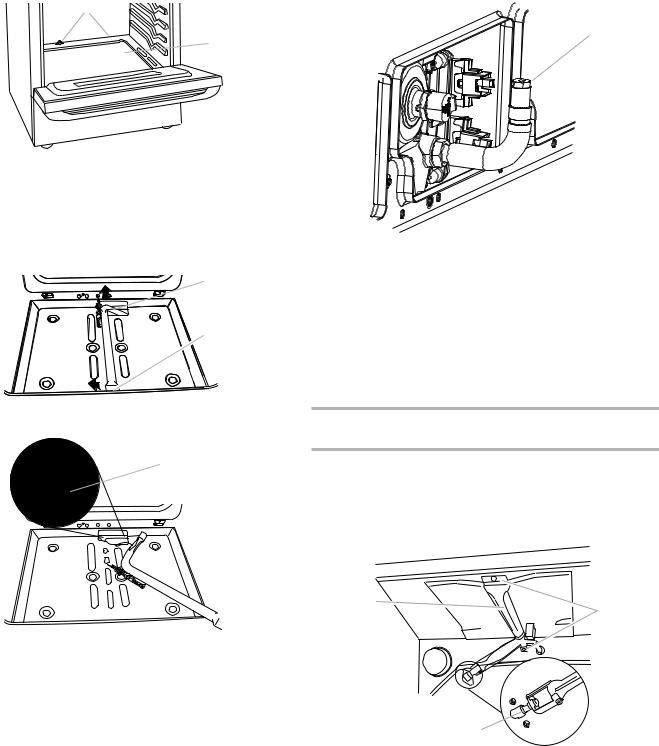
3.Lift the rear of the oven bottom up and back until the front of the panel is away from the front frame. Remove from oven and set it aside on a covered surface.
A

 B
B
A.Screws
B.Oven bottom
4.Remove 2 screws from the bake burner.
5.Slide the front of the bake burner to the side to remove tab from front of oven. Lift the back of the bake burner off the oven orifice and set the bake burner aside. Do not disconnect the wire.
 A
A
 B
B
A.Bake burner
B.Screws
 A
A
A.Oven orifice
6.Apply masking tape to the end of a 3/8" (1 cm) nut driver to help hold the gas orifice spud in the nut driver while changing it. Press nut driver down onto the gas orifice spud and remove by turning the Natural gas bake burner orifice spud counterclockwise to remove. The spud will be stamped with a “47.”
7.Replace the “47” spud with a “56” spud. Install the LP gas bake burner orifice spud, turning it clockwise until snug.
IMPORTANT: Do not overtighten.
A
A.Orifice spud
8.Position the back of the bake burner over the oven orifice, and then align the holes for the screws.
9.Reattach the bake burner with 2 screws.
10.Position the front of the oven bottom panel toward the front frame, and then lower the rear of the oven bottom panel into the oven.
11.Reattach the oven bottom panel with 2 screws and
2 washers.
To Convert Oven Broil Burner (Natural Gas to LP Gas) (on some models)
1.Remove the 1 screw from the broil burner.
2.Remove the flame spreader.
3.Remove the broil burner from the broil burner orifice hood.
NOTE: The broil burner will hang in the back of the oven while you are changing the orifice hood.
A
C
B 
D 
A.Broil burner
B.Flame spreader
C.Screws
D.Orifice hood
16
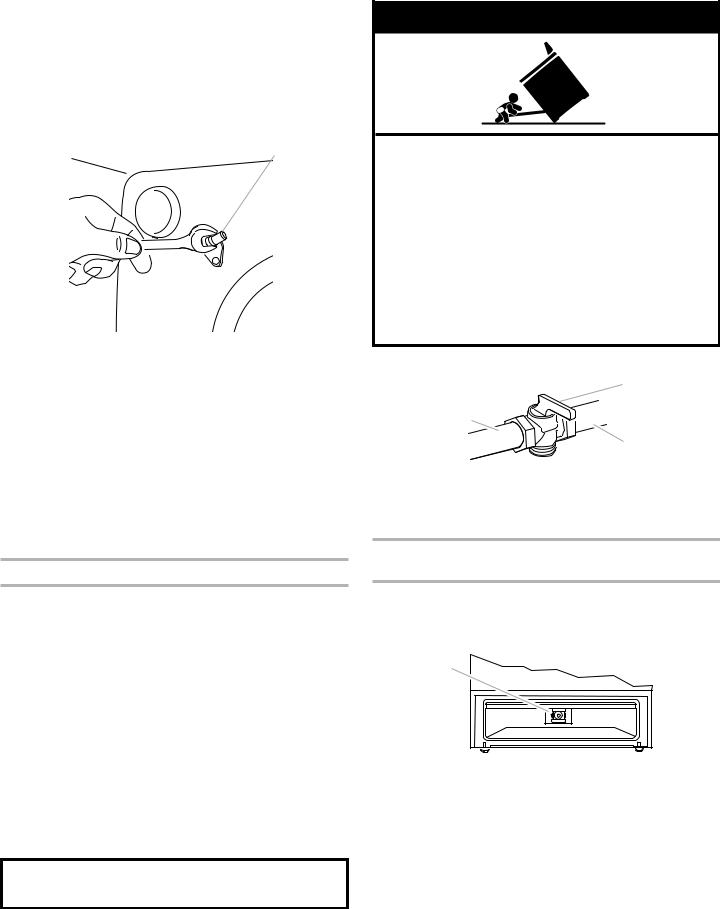
4.Apply masking tape to the end of a 3/8" (1 cm) nut driver to help hold the gas orifice spud in the nut driver while changing it. Press nut driver down onto the gas orifice spud and remove by turning the Natural gas broil burner orifice hood counterclockwise to remove. The hood will be stamped with a “155.”
5.Replace the “155” hood with a “100” hood. Install the
LP gas broiler burner orifice hood, turning it clockwise until snug.
IMPORTANT: Do not overtighten.
A
xx.x
A.Orifice hood
6.Place the broil burner on the broil burner orifice hood. Insert the broil burner ceramic igniter in the hole in the rear of the oven.
7.Replace the flame spreader with all 4 tabs facing up and the notches toward the rear of the oven.
8.Position the broil burner against the top of the oven and attach it with 1 screw.
9.Replace storage drawer. See the “Remove/Replace
Drawer” section.
10.Replace the oven door. See the “Oven Door” section.
11.Replace the oven racks.
Complete Installation (Natural Gas to LP Gas)
1.Refer to the “Make Gas Connection” section for proper connection of the range to the gas supply.
2.Refer to the “Electronic Ignition System” section for proper burner ignition and operation.
3.Refer to the “Adjust Flame Height” section for burner flame adjustments.
IMPORTANT: You may have to adjust the low setting for each cooktop burner.
Checking for proper cooktop flame is very important. The small inner cone should have a very distinct blue flame 1/4" to 1/2" (0.64 to 1.3 cm) long. The outer cone is not as distinct as the inner cone. LP gas flames have a slightly yellow tip.
4.Refer to “Complete Installation” in the “Installation Instructions” section of this manual to complete this procedure.
IMPORTANT: Make sure to save the orifices that have just been replaced in the conversion.
Natural Gas Conversion
 WARNING
WARNING
Tip Over Hazard
A child or adult can tip the range and be killed.
Install anti-tip bracket to floor or wall per installation instructions.
Slide range back so rear range foot is engaged in the slot of the anti-tip bracket.
Re-engage anti-tip bracket if range is moved.
Do not operate range without anti-tip bracket installed and engaged.
Failure to follow these instructions can result in death or serious burns to children and adults.
1. Turn the manual shut-off valve to the closed position.
B
A
C
A.Gas supply line
B.Manual shut-off valve closed position
C.To range
2.Unplug range or disconnect power.
To Convert Gas Pressure Regulator (LP Gas
to Natural Gas)
1.Remove the storage drawer. See the “Remove/Replace Drawer” section.
2.Locate gas pressure regulator at rear of the drawer compartment.
A
A. Gas pressure regulator
IMPORTANT: Do not remove the gas pressure regulator.
17
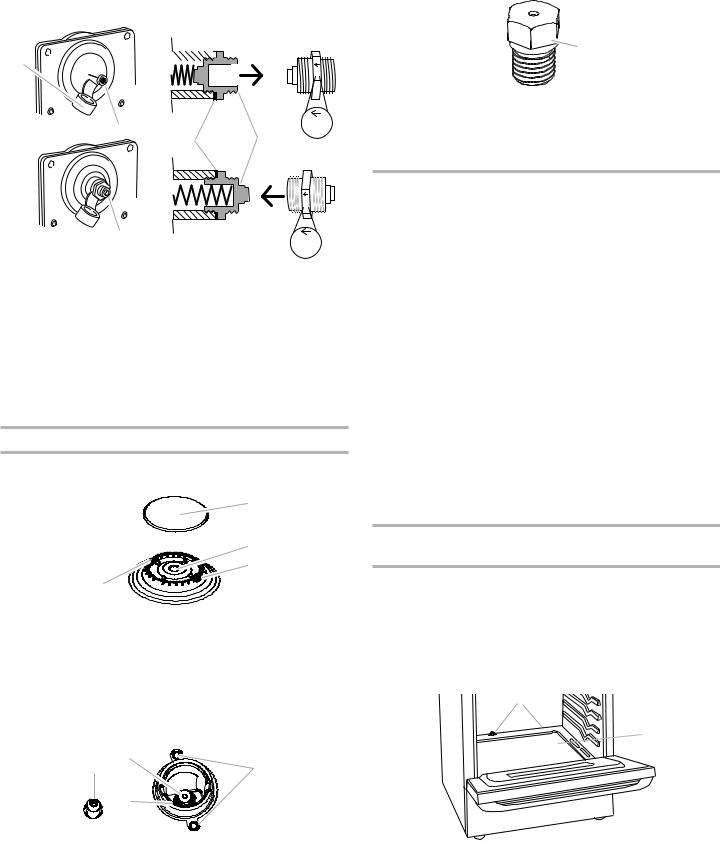
3.Remove plastic cover from gas pressure regulator cap.
4.Turn gas pressure regulator cap counterclockwise with a 5/8" (1.6 cm) combination wrench to remove.
NOTE: Do not remove the spring beneath the cap.
Side view before
A 


 LP
LP
B |
D |
E |
LP |
|
|
NG
C |
Side view after |
NG |
|
||
|
|
A.Plastic cover
B.Gas pressure regulator cap with hollow end facing out
C.Gas pressure regulator cap with solid end facing out
D.Washer
E.Gas pressure regulator cap
5.Turn over the gas pressure regulator cap and reinstall on regulator so that the solid end faces out and the marking “ NG” is facing the direction shown in the above drawing.
6.Replace plastic cover over gas pressure regulator cap.
To Convert Surface Burners (LP Gas to Natural Gas)
1.Remove burner cap.
2.Remove the burner base.
B
C
D
A
A.Igniter electrode
B.Burner cap
C.Gas tube opening
D.Burner base
3.Apply masking tape to the end of a 9/32" (7 mm) nut driver to help hold the gas orifice spud in the nut driver while changing it. Press nut driver down onto the gas orifice spud and remove by turning it counterclockwise and lifting out.
Set gas orifice spud aside.
A |
B |
D |
|
||
|
C |
|
A.Igniter electrode
B.Orifice spud
C.Orifice spud holder
D.Screws
4.Gas orifice spuds are stamped with a number on the side. Replace the LP gas orifice spud with the correct Natural gas orifice spud.
XXX |
A |
|
A. Stamped number
Refer to the following chart for the correct Natural gas orifice spud placement.
Natural Gas Orifice Spud Chart
Burner Rating |
Color |
Size (mm) |
ID Number |
|
19,000 |
BTU (ST) |
White/Gray |
1.84 |
184 |
|
|
|
|
|
18,000 |
BTU |
Blue |
1.94 |
194 |
|
|
|
|
|
17,000 |
BTU (ST) |
N/A |
1.75 |
175 |
|
|
|
|
|
17,000 |
BTU |
White/Blue |
1.90 |
190 |
|
|
|
|
|
9,200 BTU |
White/Black |
1.35 |
135 |
|
|
|
|
|
|
8,000 BTU |
White/Yellow |
1.25 |
125 |
|
|
|
|
|
|
5,000 BTU |
White/Orange |
1.00 |
100 |
|
|
|
|
|
|
1,200 BTU |
Black |
0.52 |
52 |
|
NOTE: Refer to the model/serial/rating plate located on the oven frame behind the top left-hand side of the oven door for proper sizing of spuds for each burner location.
5.Place LP gas orifice spuds in the orifice spud bag.
IMPORTANT: Keep the LP gas orifice spuds in case of reinstallation with LP gas.
6.Replace the burner base.
7.Replace burner cap.
8.Repeat steps 1 through 7 for the remaining burners.
To Convert Oven Bake Burner (LP Gas
to Natural Gas)
1.Remove the oven racks and the oven door. See the “Oven Door” section.
2.Remove 2 screws and washers at the rear of the oven bottom.
3.Lift the rear of the oven bottom up and back until the front of the panel is away from the front frame. Remove from oven and set it aside on a covered surface.
A

 B
B
A. Screws
B. Oven bottom
18
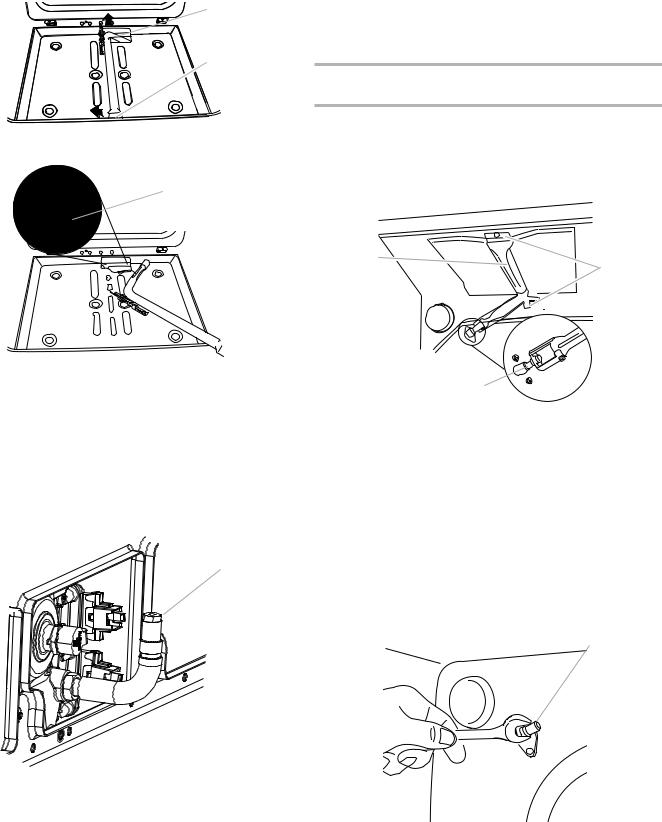
4.Remove 2 screws from the bake burner.
5.Slide the front of the bake burner to the side to remove tab from front of oven. Lift the back of the bake burner off the oven orifice and set the bake burner aside. Do not disconnect the wire.
 A
A
 B
B
A.Bake burner
B.Screws
 A
A
8.Position the back of the bake burner over the oven orifice, and then align the holes for the screws.
9.Reattach the bake burner with 2 screws.
10.Position the front of the oven bottom panel toward the front frame, and then lower the rear of the oven bottom panel into the oven.
11.Reattach the oven bottom panel with 2 screws and
2 washers.
To Convert Oven Broil Burner (LP Gas to Natural Gas) (on some models)
1.Remove 1 screw from the broil burner.
2.Remove the flame spreader.
3.Remove the broil burner from the broil burner orifice hood.
NOTE: The broil burner will hang in the back of the oven while you are changing the orifice hood.
A
C
B 

A.Oven orifice
6.Apply masking tape to the end of a 3/8" (1 cm) nut driver to help hold the gas orifice spud in the nut driver while changing it. Press nut driver down onto the gas orifice spud and remove by turning the LP gas bake burner orifice spud counterclockwise to remove. The spud will be stamped with a “56.”
7.Replace the “56” spud with a “47” spud. Install the Natural gas bake burner orifice spud, turning it clockwise until snug.
IMPORTANT: Do not overtighten.
A
D 
A.Broil burner
B.Flame spreader
C.Screws
D.Orifice hood
4.Apply masking tape to the end of a 3/8" (1 cm) nut driver to help hold the gas orifice spud in the nut driver while changing it. Press nut driver down onto the gas orifice spud and remove by turning the LP gas broil burner orifice hood counterclockwise to remove. The hood will be stamped with a “100.”
5.Replace the “100” hood with a “155” hood. Install the
Natural gas broiler burner orifice hood, turning it clockwise until snug.
IMPORTANT: Do not overtighten.
A
xx.x
A. Orifice spud
A. Orifice hood
19

6.Place the broil burner on the broil burner orifice hood. Insert the broil burner ceramic igniter in the hole in the rear of the oven.
7.Replace the flame spreader with all 4 tabs facing up and the notches toward the rear of the oven.
8.Position the broil burner against the top of the oven and attach it with 1 screw.
9.Replace the storage drawer. See the “Remove/Replace Drawer” section.
10.Replace the oven door. See the “Oven Door” section.
11.Replace the oven racks.
Complete Installation (LP Gas to Natural Gas)
1.Refer to the “Make Gas Connection” section for proper connection of the range to the gas supply.
2.Refer to the “Electronic Ignition System” section for proper burner ignition and operation.
3.Refer to the “Adjust Flame Height” section for burner flame adjustments.
IMPORTANT: You may have to adjust the low setting for each cooktop burner.
Checking for proper cooktop, bake, and broil burner flame is very important. Natural gas flames do not have yellow tips.
4.Refer to “Complete Installation” in the “Installation Instructions” section of this manual to complete this procedure.
IMPORTANT: Make sure to save the orifices that have just been replaced in the conversion.
Adjust Flame Height
Adjust Surface Burner Flame
Adjust the height of top burner flames. The cooktop “low” burner flame should be a steady blue flame approximately 1/4" (0.64 cm) high. LP gas flames have a slightly yellow tip.
A
B
A.Low flame
B.High flame
To Adjust Standard Burner:
The flame can be adjusted using the adjustment screw in the center of the valve stem. The valve stem is located directly underneath the control knob.
If the “Low” Flame Needs to Be Adjusted:
1.Light 1 burner and turn to lowest setting.
2.Remove the control knob.
Hold the knob stem with a pair of pliers. Use a small flat-blade screwdriver to turn the screw located in the center of the control knob stem until the flame is the proper size. Turning the screw clockwise will increase the flame size and counterclockwise will decrease the flame size.
A
B
C
A.Control knob stem
B.Screwdriver
C.Pliers
3.Replace the control knob.
4.Test the flame by turning the control from the low position to the high position, checking the flame at each setting.
5.Repeat the previous steps for each burner.
To Adjust Double Burner (on some models):
1.Light burner and turn to lowest setting where both inner and outer burners are lit.
2.Remove the control knob.
3.Insert a 1/8" (3 mm) flat-blade screwdriver into the adjustment locations shown in the following illustration and engage the slotted screw. Turn the screw until the flame is the proper size. Turning the screw clockwise will increase the flame size and counterclockwise will decrease the flame size.
A
B
C
A.Control knob stem
B.Screwdriver
C.Pliers
4.Replace the control knob.
5.Test the flame by turning the control from the low position to the high position, checking the flame at each setting.
Check Operation of Oven Bake Burner
Refer to the Use & Care Guide for proper operation of the oven controls.
20
